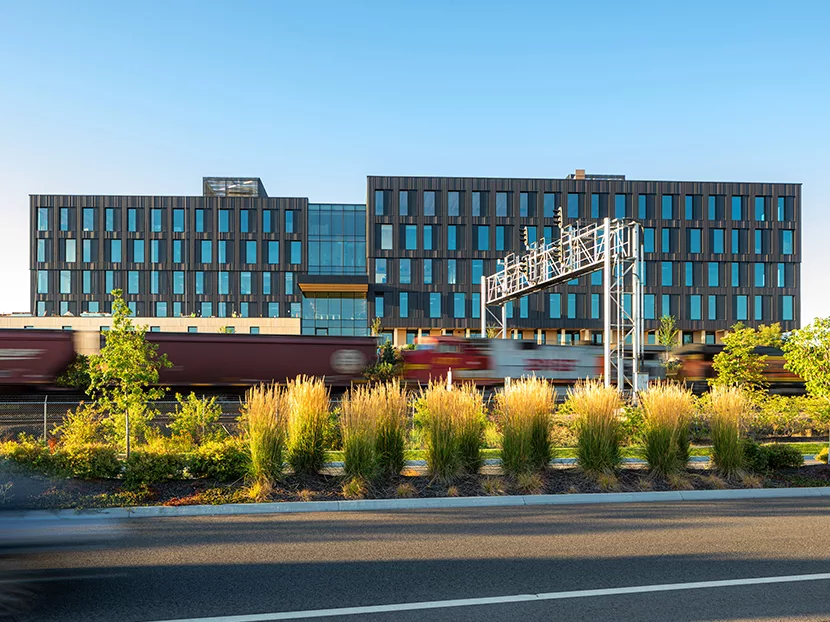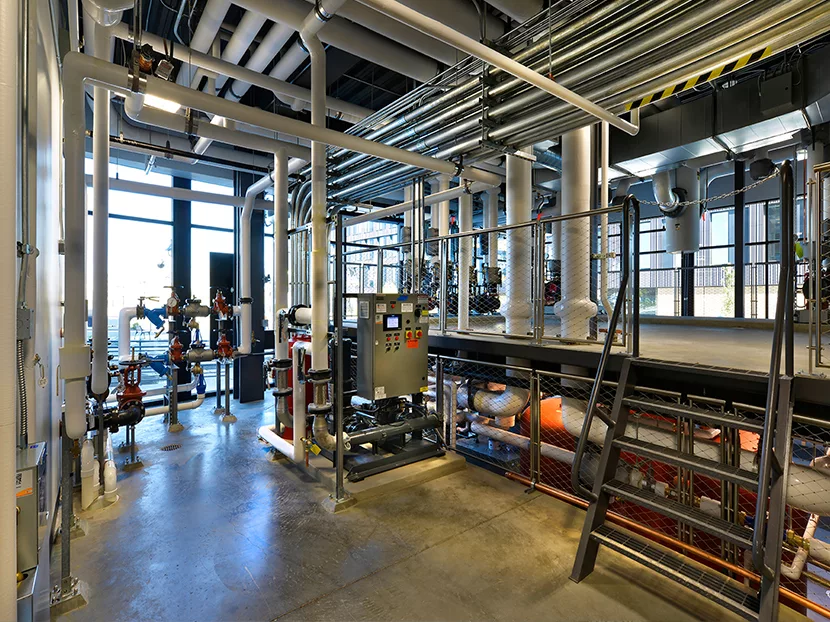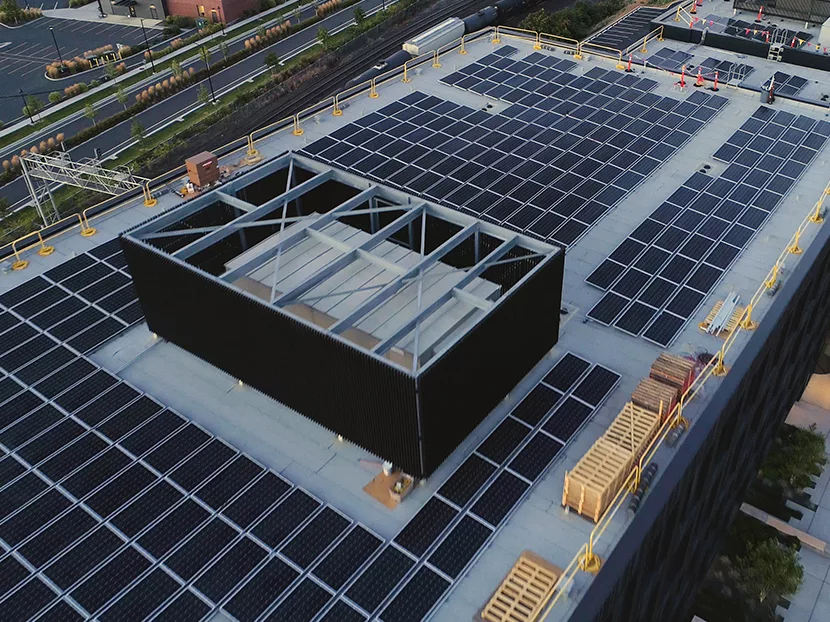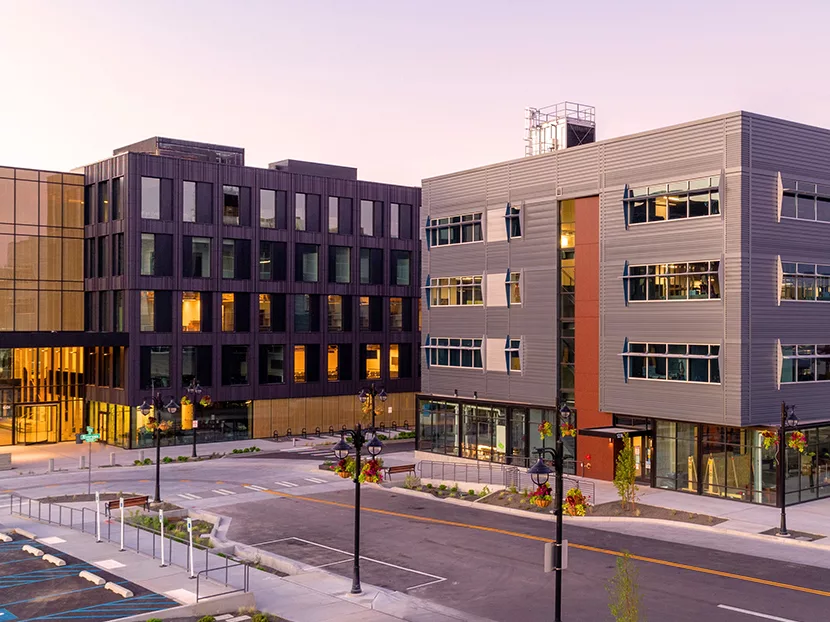The five-story, 159,000-square-foot Catalyst building opened its doors on Sept. 17, marking the culmination of a collaborative effort of diverse industry partners to create a transformative, real-world prototype for sustainable development. Anchoring the new South Landing Eco-District neighborhood in Spokane, Washington, the Catalyst building and the adjacent Scott Morris Center for Energy Innovation demonstrate new building techniques, materials and a sustainable shared energy model that is central to the goal of making Catalyst one of the largest zero energy buildings in North America and one of the first zero carbon buildings to be certified by the International Living Future Institute.
Catalyst is the result of a unique collaboration between a cross-industry team of partners including Avista, McKinstry, Katerra and Eastern Washington University (EWU). The South Landing neighborhood started with a bold vision when Avista's then-CEO and current chairman Scott Morris conceived and set out to create "the five smartest blocks in the world." Morris's idea was to create a real-world model for sustainable, efficient and forward-looking development in which smart buildings are deeply integrated with the grid and talk to each other to better manage demand, while leveraging on-site renewable energy generation and storage during peak loads.
"This is an important milestone to celebrate. With the foundation for the five smartest blocks in the world now in place, Catalyst and the South Landing Eco-District prove what is possible when industry leaders work together to think big and test bold ideas," said Morris. "What we have created is so transformative and innovative, it will serve as a new model for collaboration across industries. Together, we are reimagining the future of energy and sustainable development. What we learn will support a reliable, affordable, and clean energy future for all of us."
"Catalyst and the South Landing Eco-District are more than just another smart building project, they are the cornerstones of a fully integrated neighborhood that will serve as a living laboratory for new sustainability technologies, materials, construction techniques and operational practices," said Dean Allen, CEO of national construction and energy services firm McKinstry. "Catalyst demonstrates how the built environment can be constructed and operated for our partners, our clients, our communities and our planet to deliver sustainability and impact, not just physical space."
The Catalyst building employs innovative, integrated systems for on-site renewable energy generation using photovoltaic arrays, heating, lighting, and exhaust heat and gray water recovery, as well as Internet of Things (IoT) sensors to optimize operation.
Catalyst's design, by Michael Green Architecture, uses roughly 4,000 cubic meters of locally sourced mass timber products produced by Katerra as both structural and design elements, enabling Catalyst to achieve near-passive house levels of thermal performance. Incorporating mass timber into Catalyst also reduced the need for steel and concrete, helping to collectively offset approximately 5,000 metric tons of carbon, equating to 1,100 cars off the road for a year.
"Katerra's team is so grateful to have partnered with Avista and McKinstry on this landmark project," said Craig Curtis, Katerra's chief architect building platforms architecture. "Our hope is that Catalyst will spark a new generation of similar high-performance, low-carbon buildings. We believe mass timber is much more than a structural building material, it is an opportunity to guide building design and construction towards a future of sustainable building on an entirely new scale."
"This project is really special for MGA because it brings together a lot of the thought and ambition we have around how we can start to change both the environmental performance and the affordability of buildings," said Michael Green, principal of Michael Green Architecture. "It is the beginning of what we think will be the transformation of the construction industry, moving away from the more carbon intensive materials like concrete and steel, and towards mass timber as the best choice when making a carbon neutral building."
Catalyst and the recently opened Morris Center were designed in tandem to test the innovative new shared energy eco-district model. The main idea of the eco-district is to have buildings that work together to actively manage energy loads and balance on-site energy demand, generation and storage in real-time to reduce the impact on the grid. A centralized heating, cooling and electrical system reliably, sustainably and affordably serves the energy needs of current and future buildings in the South Landing development. In addition to heat pumps, boilers and chillers, the Morris Center houses thermal and electrical storage as well as onsite renewable energy generation that can be stored and shared. South Landing and Catalyst show how utilities can partner with property owners to operate their buildings in a manner that better utilizes the existing grid and could lead to a more affordable, clean energy future.
Eastern Washington University is the anchor tenant for Catalyst, with its College of Science, Technology, Engineering and Mathematics (CSTEM) re-locating its electrical engineering, computer science and design programs to the new building. CSTEM is also creating a new program, computer engineering, which will be housed there as well. Additionally, EWU's College of Business, several programs from the College of Health Science and Public Health, and EWU's Creative Writing MFA program will also be based in Catalyst.
This will allow more than EWU 1,000 students and faculty to work alongside private industry tenants who will provide hands-on, practical, and multi-disciplinary experiential learning opportunities.
"We are so grateful for this unique partnership with Avista, McKinstry and Katerra," said EWU Interim President David May. "Eastern is proud to be a leader in this inspiring expansion of Spokane's University District. The Catalyst creates tremendous learning and employment opportunities for our students, as academia and groundbreaking companies will unite to spark innovation."
Catalyst and the South Landing project will be unveiled in a virtual grand opening event on Sept. 17, featuring short presentations by representatives of the project partners and a video walk-through of the Catalyst building and the Morris Center. More information and the embedded livestream of the event can be found at www.catalystspokane.com/south-landing.
Eastern Washington University is the anchor tenant for Catalyst, with its College of Science, Technology, Engineering and Mathematics (CSTEM) re-locating its electrical engineering, computer science and design programs to the new building. CSTEM is also creating a new program, computer engineering, which will be housed there as well. Additionally, EWU's College of Business, several programs from the College of Health Science and Public Health, and EWU's Creative Writing MFA program will also be based in Catalyst.
This will allow more than EWU 1,000 students and faculty to work alongside private industry tenants who will provide hands-on, practical, and multi-disciplinary experiential learning opportunities.
"We are so grateful for this unique partnership with Avista, McKinstry and Katerra," said EWU Interim President David May. "Eastern is proud to be a leader in this inspiring expansion of Spokane's University District. The Catalyst creates tremendous learning and employment opportunities for our students, as academia and groundbreaking companies will unite to spark innovation."
Catalyst and the South Landing project will be unveiled in a virtual grand opening event on Sept. 17, featuring short presentations by representatives of the project partners and a video walk-through of the Catalyst building and the Morris Center. More information and the embedded livestream of the event can be found at www.catalystspokane.com/south-landing.









